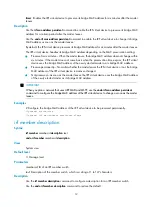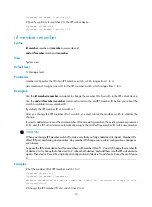
3
Parameters
|
: Filters command output by specifying a regular expression. For more information about regular
expressions, see CLI configuration
in the
Fundamentals Configuration Guide
.
begin
: Displays the first line that matches the specified regular expression and all lines that follow.
exclude
: Displays all lines that do not match the specified regular expression.
include
: Displays all lines that match the specified regular expression.
regular-expression
: Specifies a regular expression, which is a case sensitive string of 1 to 256 characters.
Description
Use the
display irf configuration
command to display the pre-configurations of all IRF member switches.
The command displays the member ID, priority, IRF port state, and port information.
NOTE:
The pre-configurations take effect at the reboot of the switch.
Examples
# Display the pre-configurations of all IRF member switches.
<Sysname> display irf configuration
MemberID NewID IRF-Port1 IRF-Port2
1 1 disable Ten-GigabitEthernet1/1/2
2 2 Ten-GigabitEthernet2/2/1 disable
Table 2
display irf configuration command output description
Field Description
Switch Member
ID.
New-ID
The member ID configured for a switch after its reboot.
IRF-Port1
The left IRF port of a switch after its reboot.
•
If it is displayed as
x
, it indicates that the IRF port is bound with the physical
IRF port
x
.
•
If it is displayed as
x.y
, it indicates that the IRF port is aggregated from the
physical IRF ports
x
and
y
.
•
If it is displayed as
disable
, it indicates that the IRF port is not enabled.
IRF-Port2
The right IRF port of a switch after its reboot.
•
If it is displayed as
x
, it indicates that the IRF port is bound with the physical
IRF port
x
.
•
If it is displayed as
x.y
, it indicates that the IRF port is aggregated from the
physical IRF ports
x
and
y
.
•
If it is displayed as
disable
, it indicates that the IRF port is not enabled.
display irf topology
Syntax
display irf topology
[
|
{
begin
|
exclude
|
include
}
regular-expression
]











































